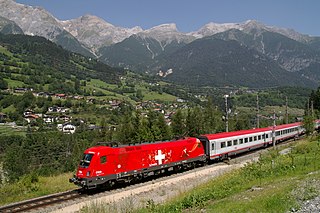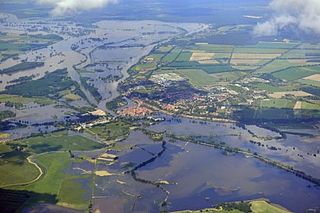
Vorarlberg is the westernmost state of Austria. It has the second-smallest geographical area after Vienna and, although it also has the second-smallest population, it is the state with the second-highest population density. It borders three countries: Germany, Switzerland, and Liechtenstein. The only Austrian state that shares a border with Vorarlberg is Tyrol, to the east.

Suceava County is a county of Romania. Most of its territory lies in the southern part of the historical region of Bukovina, while the remainder forms part of Western Moldavia proper.

Sankt Anton am Arlberg, commonly referred to as St Anton, is a village and ski resort in the Austrian state of Tyrol. It lies in the Tyrolean Alps, with aerial tramways and chairlifts up to 2,811 m (9,222 ft), yielding a vertical drop of 1,507 m (4,944 ft). It is also a popular summer resort among hikers, trekkers and mountaineers.

Landeck is a city in the Austrian state of Tyrol, the capital of the district of Landeck.

Zürs is one of the most renowned winter sports resorts in the Alps. Located in the westernmost Austrian state of Vorarlberg, almost directly on the border to North Tyrol, near the Flexenpass, Zürs is part of the Arlberg region, which also includes Lech, Oberlech, Zug, and Stubenbach. This region offers 87 ski-lifts, 200 kilometers of deep snow slopes and 305 km of ski runs. It has several hotels and pensions, with a total of over 1,700 beds. It is popular for its downhill skiing, but also for its backcountry skiing and its Olympic skiing champions. About four kilometers north of Zürs is Lech am Arlberg, another ski resort which is linked to Zürs not only via road, but also via ski lifts and pistes.

Eastern Alps is the name given to the eastern half of the Alps, usually defined as the area east of a line from Lake Constance and the Alpine Rhine valley, up to the Splügen Pass at the Alpine divide, and down the Liro River to Lake Como in the south. The peaks and mountain passes are lower than the Western Alps, while the range itself is broader and less arched.

From February to April 2006 many rivers across Europe, especially the Elbe and Danube, swelled due to heavy rain and melting snow and rose to record levels. These are the longest rivers in Central Europe.

The Arlberg Railway, which connects the Austrian cities Innsbruck and Bludenz, is Austria's only east-west mountain railway. It is one of the highest standard gauge railways in Europe and the second highest in Austria, after the Brenner. The 136.7 km line is a highly problematic mountain railway, in part because it is threatened by avalanches, mudslides, rockfalls and floods. It is operated by the Austrian Federal Railways (ÖBB) and frequented by international trains, including the Orient Express.
Cyclone Emma was an extratropical cyclone that passed through several mainly Central European countries, on Saturday March 1, 2008, killing at least twelve people in Austria, Germany, Poland and the Czech Republic. Wind speeds reached up to 155–180 km/h (96–112 mph) in Austria and the Czech Republic. Major infrastructure disruptions and some injuries were also reported in Belgium, France, Switzerland, and the Netherlands.

The 2009 European floods were a series of natural disasters that took place in June 2009 in Central Europe. Austria, the Czech Republic, Germany, Hungary, Poland, Romania, Serbia, Slovakia and Turkey were all affected. The heavy rains caused overflowing of the rivers Oder, Vistula, Elbe and Danube. At least 12 people were killed in the Czech Republic and one in Poland.
In the NUTS codes of Romania (RO), the three levels are:

The global weather activity of 2010 includes major meteorological events in the Earth's atmosphere during the year, including winter storms, hailstorms, out of season monsoon rain storms, extratropical cyclones, gales, microbursts, flooding, rainstorms, tropical cyclones, and other severe weather events.
The 2010 Romanian floods were the result of an extreme weather event that struck Romania in late June 2010. Currently, at least 21 people died. The north-east of the country, especially Suceava County was most affected. Also affected was the Chernivtsi Oblast in neighbouring Ukraine.

Cyclone Andrea was an intense European windstorm that affected western and central Europe in early January 2012.
The 2012 Romanian floods were the result of an extreme weather event that struck Romania in late May 2012. Authorities reported four deaths throughout Romania. The south-east of the country, especially Vrancea County was most affected. Also affected were the provinces of Kyustendil, Blagoevgrad and Sofia in neighbouring Bulgaria.

The Vorarlberg Railway denotes a through line running through the Austrian state of Vorarlberg. Its route is similar to the Rheintal/Walgau Autobahn from the border between Lindau and Hörbranz to Bludenz, where it connects to the Arlberg Railway. The entire route in Austria is owned and is operated up to Lindau-Insel by the Austrian Federal Railways.

Extreme flooding in Central Europe began after several days of heavy rain in late May and early June 2013. Flooding and damages primarily affected south and east German states, western regions of the Czech Republic (Bohemia), and Austria. In addition, Slovakia, Poland and Hungary were affected to a lesser extent. The flood crest progressed down the Elbe and Danube drainage basins and tributaries, leading to high water and flooding along their banks.

In July 2021, several European countries were affected by severe floods. Some were catastrophic, causing deaths and widespread damage. The floods started in the United Kingdom as flash floods causing some property damage and inconvenience. Later floods affected several river basins across Europe including Austria, Belgium, Croatia, Germany, Italy, Luxembourg, the Netherlands, and Switzerland. At least 243 people died in the floods, including 196 in Germany, 43 in Belgium, two in Romania, one in Italy and one in Austria.
2021 saw some of the most extreme flooding on record, in large part driven by climate change. The insurance industry analysis group Swiss RE found that 31% of global insurance losses were from flooding, and that nearly a fifth of the economic damage from natural disasters was uninsured.



















